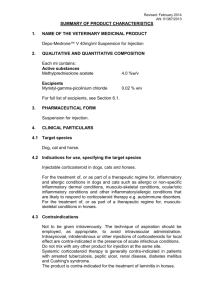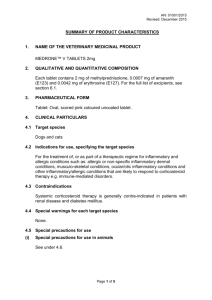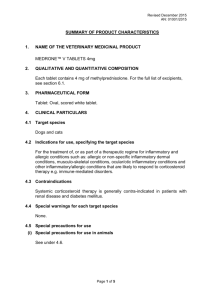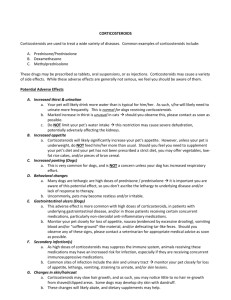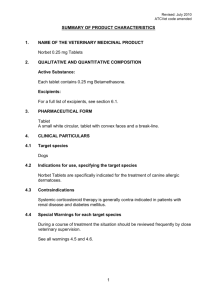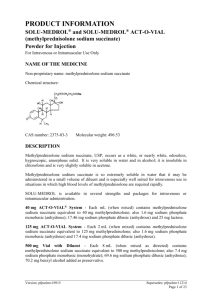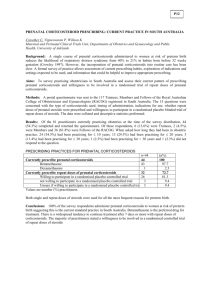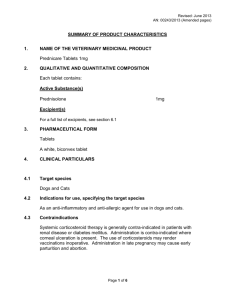data sheet
advertisement
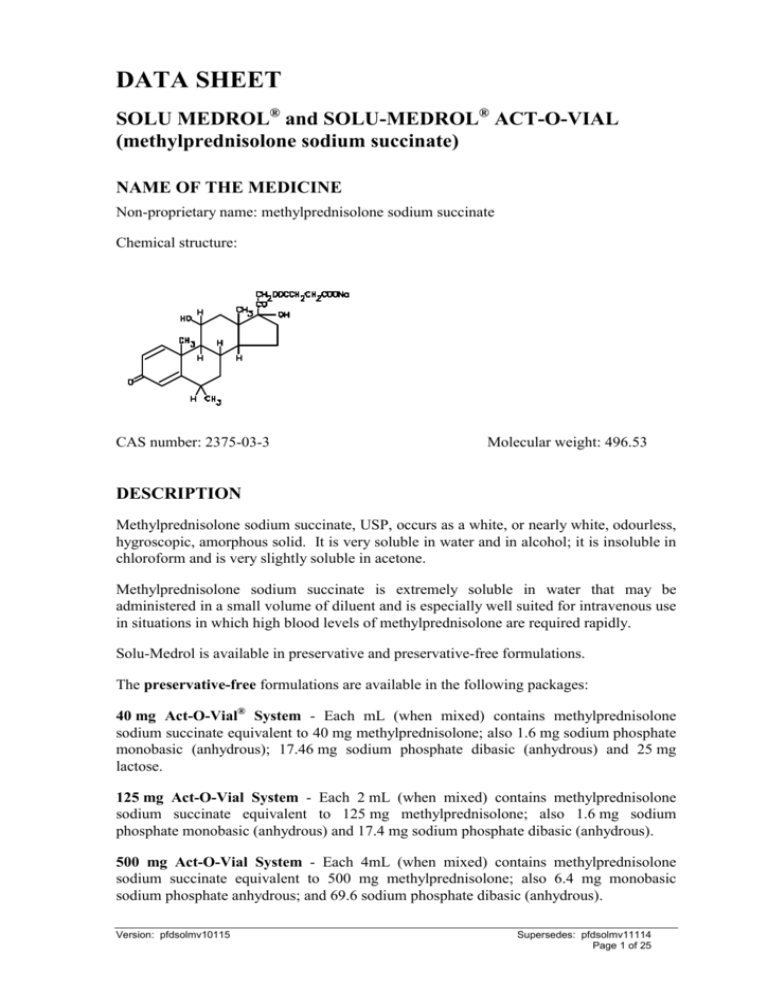
DATA SHEET SOLU MEDROL® and SOLU-MEDROL® ACT-O-VIAL (methylprednisolone sodium succinate) NAME OF THE MEDICINE Non-proprietary name: methylprednisolone sodium succinate Chemical structure: CAS number: 2375-03-3 Molecular weight: 496.53 DESCRIPTION Methylprednisolone sodium succinate, USP, occurs as a white, or nearly white, odourless, hygroscopic, amorphous solid. It is very soluble in water and in alcohol; it is insoluble in chloroform and is very slightly soluble in acetone. Methylprednisolone sodium succinate is extremely soluble in water that may be administered in a small volume of diluent and is especially well suited for intravenous use in situations in which high blood levels of methylprednisolone are required rapidly. Solu-Medrol is available in preservative and preservative-free formulations. The preservative-free formulations are available in the following packages: 40 mg Act-O-Vial® System - Each mL (when mixed) contains methylprednisolone sodium succinate equivalent to 40 mg methylprednisolone; also 1.6 mg sodium phosphate monobasic (anhydrous); 17.46 mg sodium phosphate dibasic (anhydrous) and 25 mg lactose. 125 mg Act-O-Vial System - Each 2 mL (when mixed) contains methylprednisolone sodium succinate equivalent to 125 mg methylprednisolone; also 1.6 mg sodium phosphate monobasic (anhydrous) and 17.4 mg sodium phosphate dibasic (anhydrous). 500 mg Act-O-Vial System - Each 4mL (when mixed) contains methylprednisolone sodium succinate equivalent to 500 mg methylprednisolone; also 6.4 mg monobasic sodium phosphate anhydrous; and 69.6 sodium phosphate dibasic (anhydrous). Version: pfdsolmv10115 Supersedes: pfdsolmv11114 Page 1 of 25 The Solu-Medrol formulations preserved with benzyl alcohol are available in the following packages: 1 gram Vial with Diluent - Each 16 mL (when mixed as directed) contains methylprednisolone sodium succinate equivalent to 1 gram methylprednisolone; also 14.8 mg sodium phosphate monobasic (monohydrate); 139.2 mg sodium phosphate dibasic (anhydrous); 140.4 mg benzyl alcohol added as preservative. 2 gram Vial with Diluent - Each 31.2 mL (when mixed as directed) contains methylprednisolone sodium succinate equivalent to 2 grams methylprednisolone; also 29.5 mg sodium phosphate monobasic (monohydrate); 277.7 mg sodium phosphate dibasic (anhydrous); 280.8 mg benzyl alcohol added as preservative. When necessary, the pH of each formula was adjusted with sodium hydroxide so that the pH of the reconstituted solution is within the USP specified range of 7 to 8 and the tonicities are, for the 40 mg per mL solution, 0.50 osmolar; for the 125 mg per 2 mL, 500 mg per 8 mL and 1 gram per 16 mL solutions, 0.40 osmolar; for the 2 gram per 31.2 mL solutions, 0.42 osmolar (Isotonic saline = 0.28 osmolar). IMPORTANT - When reconstituting Solu-Medrol, use only the accompanying diluent. The diluent with the Act-O-Vial system is sterile Water for Injections and is preservative free. The diluent provided with Solu-Medrol 1 g and 2 g is a bacteriostatic Water for Injections containing benzyl alcohol. PHARMACOLOGY Pharmacodynamics Methylprednisolone is a potent anti-inflammatory steroid. It has a greater antiinflammatory potency than prednisolone and even less tendency than prednisolone to induce sodium and water retention. Methylprednisolone sodium succinate has the same metabolic and anti-inflammatory actions as methylprednisolone. When given parenterally and in equimolar quantities, the two compounds are equivalent in biologic activity. The relative potency of Solu-Medrol sterile powder (methylprednisolone sodium succinate) and hydrocortisone sodium succinate, as indicated by depression of eosinophil count, following intravenous administration, is at least four to one. This is in good agreement with the relative oral potency of methylprednisolone and hydrocortisone. Pharmacokinetics Methylprednisolone pharmacokinetics is linear, independent of route of administration Absorption After an intravenous infusion of Solu-Medrol, 30 mg/kg over a 20 minute period or 1 g over 30 to 60 minutes, peak methyl-prednisolone plasma concentrations of approximately 20 mcg/mL were achieved. Peak methylprednisolone levels of 42-47 mcg/ 100 mL were reported following a single 40mg IV bolus injection to six adult male volunteers. Version: pfdsolmv10115 Supersedes: pfdsolmv11114 Page 2 of 25 Peak methylprednisolone plasma levels of 33.67 mcg/100 mL were achieved in two hours after a single 40 mg IM injection to 22 adult male volunteers. Although with intramuscular (IM) injection lower peak levels are obtained than with intravenous (IV) injection, the plasma levels persist longer such that the extent of methylprednisolone absorption is equivalent with either route of administration. Distribution Methylprednisolone is widely distributed throughout the body and is described by a twocompartment model. Its apparent volume of distribution is approximately 1.4 mL/kg and its total clearance is approximately 5 to 6 mL/min/kg. Methylprednisolone, like many CYP3A4 substrates, may also be a substrate for the ATPbinding cassette (ABC) transport protein p-glycoprotein, influencing tissue distribution and interactions with other medicines. Solu-Medrol readily crosses the blood-brain barrier into the central nervous system with peak CSF levels being 5 - 6% of the corresponding plasma levels. Methylprednisolone peak CSF levels occurred within five minutes to one hour after IV administration of a 500 mg dose to patients with lupus cerebritis. Methylprednisolone and the sodium succinate salt crosses the placental barrier. Although there is no data regarding methylprednisolone passage into breast milk of humans, it is present in breast milk of animals. Metabolism Solu-Medrol, the sodium succinate ester of methyl-prednisolone, is rapidly and extensively hydrolysed in vivo by cholinesterases to free methylprednisolone. In humans, methylprednisolone is metabolised in the liver to inactive metabolites, the major ones being 20B-hydroxymethylprednisone and 20 alpha-hydroxy-6amethylprednisone. Metabolism in the liver occurs primarily via the CYP3A4. For a list of drug interactions based on CYP3A4-mediated metabolism (see INTERACTIONS WITH OTHER MEDICINES). Excretion The mean elimination half-life ranges for total methylprednisolone is in the range of 1.8 to 5.2 hours. The plasma protein binding of methylprednisolone in humans is approximately 77%. Total body clearance following intravenous or intramuscular injection of methylprednisolone to healthy adult volunteers is approximately 15 - 16 L/hr. In adult volunteers receiving 40 mg Solu-Medrol, either IM or IV, renal clearance is 0.61 - 0.83 L/hr. Methylprednisolone clearance is altered by concurrent administration of troleandomycin, erythromycin, rifampin, anti-convulsants, and theophylline. Following IV administration of radiolabelled 6-methyl-prednisolone to six cancer patients, 75% of total reactivity was recovered in the urine after 96 hours and 9% in the Version: pfdsolmv10115 Supersedes: pfdsolmv11114 Page 3 of 25 faeces after five days. Twenty percent of the total dose was excreted in the bile, but the time course was not cited. INDICATIONS Endocrine Disorders Primary or secondary adrenocortical insufficiency (hydrocortisone or cortisone is the drug of choice; synthetic analogues may be used in conjunction with mineralocorticoids where applicable; in infancy, mineralocorticoid supplementation is of particular importance). Acute adrenocortical insufficiency (hydrocortisone or cortisone is the drug of choice; mineralocorticoid supplementation may be necessary, particularly when synthetic analogues are used). Preoperatively and in the event of serious trauma or illness, in patients with known adrenal insufficiency or when adrenocortical reserve is doubtful. Congenital adrenal hyperplasia Nonsuppurative thyroiditis Hypercalcaemia associated with cancer. Rheumatic Disorders As adjunctive therapy for short-term administration (to tide the patient over an acute episode or exacerbation) in: Post-traumatic osteoarthritis Synovitis of osteoarthritis Rheumatoid arthritis including juvenile rheumatoid arthritis (selected cases may require low-dose maintenance therapy) Acute and subacute bursitis Epicondylitis Acute non-specific tenosynovitis Acute gouty arthritis Psoriatic arthritis Ankylosing spondylitis. Collagen Diseases (Immune and Complex Diseases) During an exacerbation or as maintenance therapy in selected cases of: Version: pfdsolmv10115 Supersedes: pfdsolmv11114 Page 4 of 25 Systemic lupus erythematosus (and lupus nephritis) Acute rheumatic carditis Systemic dermatomyositis (polymyositis) Polyarteritis nodosa Good pasture's syndrome. Dermatologic Diseases Pemphigus Severe erythema multiforme (Stevens-Johnson syndrome) Exfoliative dermatitis Bullous dermatitis herpetiformis Severe seborrhoeic dermatitis Severe psoriasis Mycosis fungoides. Allergic States Control of severe or incapacitating allergic conditions intractable to adequate trials of conventional treatment in: Bronchial asthma Contact dermatitis Atopic dermatitis Serum sickness Seasonal or perennial allergic rhinitis Drug hypersensitivity reactions Urticarial transfusion reactions Acute non-infectious laryngeal oedema (adrenaline is the drug of first choice). Ophthalmic Diseases Severe acute and chronic allergic and inflammatory processes involving the eye, such as: Herpes zoster ophthalmicus Iritis, iridocyclitis Chorioretinitis Diffuse posterior uveitis and choroiditis Optic neuritis Version: pfdsolmv10115 Supersedes: pfdsolmv11114 Page 5 of 25 Sympathetic ophthalmia Anterior segment inflammation Allergic conjunctivitis Allergic corneal marginal ulcers Keratitis. Gastrointestinal Diseases To tide the patient over a critical period of the disease in: Ulcerative colitis (systemic therapy) Regional enteritis (systemic therapy). Respiratory Diseases Symptomatic sarcoidosis Berylliosis Fulminating or disseminated pulmonary tuberculosis when used concurrently with appropriate anti-tuberculous chemotherapy Loeffler's Syndrome not manageable by other means Aspiration pneumonitis SOLU MEDROL is beneficial as adjunctive therapy in the treatment of AIDS patients with moderate to severe pneumocystis jiroveci pneumonia when given in the first 72 hours of initial anti-pneumocystis treatment. Due to the increased rate of reactivation of tuberculosis in AIDS patients, consideration should be given to the administration of antimycobacteria therapy if corticosteroids are used in this high risk group. The patient should also be observed for activation of other latent infections. Haematologic Disorders Acquired (autoimmune) haemolytic anaemia Idiopathic thrombocytopaenia purpura in adults (IV only; IM administration is contraindicated) Secondary thrombocytopaenia in adults Erythroblastopenia (RBC anaemia) Congenital (erythroid) hypoplastic anaemia Neoplastic Diseases For palliative management of: Leukaemias and lymphomas in adults Version: pfdsolmv10115 Supersedes: pfdsolmv11114 Page 6 of 25 Acute leukaemia of childhood Terminal Cancer To improve quality of life in patients with terminal cancer Oedematous States To induce diuresis or remission of proteinuria in the nephrotic syndrome, without uraemia, of the idiopathic type or that due to lupus erythematosus. Nervous System Cerebral oedema from tumour - primary or metastatic and/or associated with surgical or radiation therapy Acute exacerbations of multiple sclerosis. Acute spinal cord injury - the treatment should begin within eight hours of injury. Cardiovascular Conditions Shock secondary to adrenocortical insufficiency or shock unresponsive to conventional therapy when adrenal cortical insufficiency may be present. (Hydrocortisone is generally the drug of choice. When mineralocorticoid activity is undesirable, methylprednisolone may be preferred.) Miscellaneous Tuberculous meningitis with subarachnoid block or impending block when used concurrently with appropriate antituberculous chemotherapy. Trichinosis with neurologic or myocardial involvement. Organ Transplantation Prevention of nausea and vomiting associated with cancer chemotherapy. DOSAGE AND ADMINISTRATION Warning - Some Solu-Medrol formulations contain benzyl alcohol. Benzyl alcohol (as contained in the accompanying diluent for the 1 g and 2 g vials) has been reported to be associated with a fatal "gasping syndrome" in premature infants (see DESCRIPTION and PRECAUTIONS, Paediatric Use). Because of possible physical incompatibilities, Solu-Medrol should not be diluted or mixed with other solutions. Since complications of treatment with glucocorticoids are dependent on the size of the dose and the duration of treatment, a risk/benefit decision must be made in each individual case as to dose and duration of treatment and as to whether daily or intermittent therapy should be used (see PRECAUTIONS). The lowest possible dose of corticosteroid should be used to control the condition under treatment and when reduction in dosage is possible, the reduction should be gradual (see PRECAUTIONS). Version: pfdsolmv10115 Supersedes: pfdsolmv11114 Page 7 of 25 Use only the accompanying diluent (bacteriostatic Water for Injections with benzyl alcohol or the sterile Water for Injection when reconstituting Solu-Medrol) (see DESCRIPTION). Parenteral drug products should be inspected visually for particulate matter and discolouration prior to administration, whenever solution and container permit. SOLU MEDROL (methylprednisolone sodium succinate) may be administered by intravenous or intra-muscular injection, or by intravenous infusion, the preferred method for initial emergency use being intravenous injection. To administer by intravenous (or intramuscular) injection, prepare solution with the diluent provided. Following the initial emergency period, consideration should be given to employing a longer acting injectable preparation or an oral preparation. There are reports of cardiac arrhythmias and/or cardiac arrest following the rapid administration of large IV doses of Solu-Medrol (greater than 0.5 gram administered over a period of less than 10 minutes). Bradycardia has been reported during or after the administration of large doses of methylprednisolone sodium succinate, and may be unrelated to the speed or duration of infusion. As adjunctive therapy in life threatening conditions the recommended dose of SoluMedrol sterile powder is 30 mg per kg of methylprednisolone sodium succinate, given IV over a period of at least 30 minutes. This dose may be repeated every 4 - 6 hours for up to 48 hours. Pulse dosing for corticosteroid responsive diseases in exacerbation and/or unresponsive to standard therapy (eg. lupus nephritis, rheumatoid arthritis, etc.). Suggested schedules: Rheumatic disorders 1 g/day for one, two, three or four days IV or 1 g/month for six months IV. Systemic lupus erythematosus 1 g/day for three days IV. Multiple sclerosis 1 g/day for three days IV or 1 g/day for five days IV. Oedematous states e.g. glomerulonephritis, lupus nephriti 30 mg/kg every other day for four days IV or 1 g/day for three, five or seven days IV. The regimen should be administered over at least 30 minutes, and may be repeated if improvement has not occurred within a week after therapy or as patient's condition dictates. Terminal Cancer - Quality of Life Prospective controlled studies have shown that SOLU MEDROL 125 mg administered intravenously daily for up to eight weeks, significantly improves quality of life in patients with terminal cancer. Version: pfdsolmv10115 Supersedes: pfdsolmv11114 Page 8 of 25 Prevention of nausea and vomiting associated with cancer chemotherapy. Suggested schedules: Mild to moderately emetogenic chemotherapy: Administer SOLU MEDROL 250 mg IV over at least five minutes one hour before chemotherapy, at the initiation of chemotherapy, and at the time of discharge. A chlorinated phenothiazine may also be used with the first dose of SOLU MEDROL for increased effect. Severely emetogenic chemotherapy: Administer SOLU MEDROL 250 mg IV over at least five minutes with appropriate doses of metoclopramide or a butyrophenone one hour before chemotherapy, then Solu-Medrol 250 mg IV at the initiation of chemotherapy and at time of discharge. Acute spinal cord injury - Treatment should begin within 8 hours of injury For patients initiated on treatment within 3 hours of injury: Administer 30 mg/kg as an IV bolus over a 15-minute period, followed by a 45 minute pause, and then a continuous IV infusion of 5.4 mg/kg/h for 23 hours. For patients initiated on treatment within 3 to 8 hours of injury: Administer 30 mg/kg as an IV bolus over a 15-minute period, followed by a 45-minute pause, and then a continuous IV infusion of 5.4 mg/kg/h for 47 hours. There should be a separate intravenous site for the infusion pump. The treatment should begin within eight hours of injury. Pneumocystis jiroveci pneumonia in patients with AIDS A number of dosage schedules have been used. One approach is to administer 40mg Solu-Medrol every 6 to 12 hours with gradual tapering over a maximum of 21 days or until the end of the pneumocystis therapy. Therapy should be started within 72 hours of initial anti-pneumocystis treatment. In other indications, initial dosage will vary from 10 – 500 mg depending on the clinical problem being treated. Larger doses may be required for short term management of severe, acute conditions. The initial dose, up to 250 mg, should be given intravenously over a period of at least five minutes and if greater than 250 mg, should be given over at least 30 minutes. It should not be less than 0.5 mg per kg every 24 hours. Subsequent doses may be given intravenously or intra-muscularly at intervals dictated by the patient's response and clinical condition. Corticosteroid therapy is an adjunct to, and not a replacement for, conventional therapy. Use in Paediatrics Dosage may be reduced for infants and children but should be governed more by the severity of the condition and response of the patient than by age or size. It should not be less than 0.5 mg per kg every 24 hours. Benzyl alcohol has been associated with “gasping syndrome” in premature infants (see PRECAUTIONS, Paediatric Use). Version: pfdsolmv10115 Supersedes: pfdsolmv11114 Page 9 of 25 Directions for using the Act-O-Vial System 1. Tap to ensure that the powder is at base of vial and away from the central stopper. 2. Place the Act-O-Vial on a flat, stable surface and hold with one hand. 3. Press down firmly on the plastic activator with the palm of the other hand to force diluent into the lower compartment. 4. Gently mix the solution by turning the vial upside down a number of times. DO NOT SHAKE THE VIAL. 5. Remove plastic tab covering centre of stopper. 6. Sterilise top of stopper with an alcohol swab. 7. Whilst on a flat surface, insert needle squarely through centre of stopper until tip is just visible. Invert vial to allow the solution to flow into the top compartment and withdraw the dose. Preparation of Solutions To prepare solutions for intravenous infusion, first reconstitute Solu-Medrol (methylprednisolone sodium succinate) with the diluent provided. Therapy may be initiated by administering Solu-Medrol (methylprednisolone sodium succinate) intravenously over a period of at least five minutes (e.g., doses up to 250 mg) to at least 30 minutes (e.g., doses of 250 mg or more). Subsequent doses may be withdrawn and administered similarly. If desired, the medication may be administered in dilute solutions by admixing the reconstituted product with dextrose in 5% in water, normal saline, dextrose 5% in 0.45% or 0.9% sodium chloride; the resulting solutions are physically and chemically stable for 48 hours. Parenteral products should be inspected visually for particulate matter and discolouration prior to administration wherever solution and container permit. Compatibility and Stability The IV compatibility and stability of methylprednisolone sodium succinate solutions and with other drugs in intravenous admixtures is dependent on admixture pH, concentration, time, temperature and the ability of methylprednisolone to solubilise itself. Thus, to avoid compatibility and stability problems, whenever possible, it is recommended that SOLU MEDROL (methylprednisolone sodium succinate) be administered separate from other drugs and as either IV medication chamber, or as an IV "piggy-back" solution. Drugs that are physically incompatible in solution with methylprednisolone sodium succinate include, but are not limited to: allopurinol sodium, doxapram hydrochloride, tigecycline, diltiazem hydrochloride, calcium gluconate, vecuronium bromide, rocuronium bromide, cisatracurium besylate, glycopyrrolate, propofol. CONTRAINDICATIONS Methylprednisolone sodium succinate is contraindicated: in patients who have systemic fungal infections. Version: pfdsolmv10115 Supersedes: pfdsolmv11114 Page 10 of 25 in patients with known hypersensitivity to methylprednisolone or any component of the formulation. for use by intrathecal, epidural, local injection or any other unspecified route of administration. Administration of live or live, attenuated vaccines is contraindicated in patients receiving immunosuppressive doses of corticosteroids (see PRECAUTIONS, Immunosuppressive Effects/Increased Susceptibility to Infections). PRECAUTIONS The lowest possible dose of corticosteroid should be used to control the condition under treatment and when reduction in dosage is possible, the reduction should be gradual. Since complications of treatment with glucocorticoids are dependent on the size of the dose and the duration of treatment, a risk/benefit decision must be made in each individual case as to dose and duration of treatment and as to whether daily or intermittent therapy should be used. Immunosuppressive Effects/Increased Susceptibility to Infections Due to their suppression of the inflammatory response and immune function, corticosteroids may increase susceptibility to fungal, bacterial and viral infections and their severity. Chicken pox and measles, for example, can have a more serious or even fatal course in non-immune children or adults on corticosteroids. How the dose, route and duration of corticosteroid administration affect the risk of developing a disseminated infection is not known. The contribution of the underlying disease and/or prior corticosteroid treatment to the risk is also not known. If exposed to chicken pox, they should seek urgent medical attention. Passive immunisation is recommended if nonimmune patients who come into contact with chicken pox. If a diagnosis of chicken pox is confirmed the illness warrants specialist care and urgent treatment. The immunosuppressive effects of corticosteroids may also result in activation of latent infection or exacerbation of existing infection. Corticosteroids should be used with great care in patients with known or suspected parasitic infections such as Strongyloides infestation. In such patients, corticosteroid-induced immunosuppression may lead to Strongyloides hyperinfection and dissemination with widespread larval migration, often accompanied by severe enterocolitis and potentially fatal gram-negative septicaemia. It is important to note that corticosteroids may increase susceptibility to infection, may mask some signs of infection, which may reach an advanced stage before the infection is recognised, and new infections may appear during their use. There may be decreased resistance and inability to localise infection when corticosteroids are used. Infections with any pathogen including viral, bacterial, fungal, protozoan or helminthic organisms, in any location in the body, may be associated with the use of corticosteroids alone or in combination with other immunosuppressive agents that affect cellular immunity, humoral immunity, or neutrophil function. These infections may be mild, but can be severe and at times fatal. With increasing doses of corticosteroids, the rate of occurrence of infectious complications increases. Version: pfdsolmv10115 Supersedes: pfdsolmv11114 Page 11 of 25 Administration of live or live, attenuated vaccines is contraindicated in patients receiving immunosuppressive doses of corticosteroids. Killed or inactivated vaccines may be administered to patients receiving immunosuppressive doses of corticosteroids; however, the response to such vaccines may be diminished. Indicated immunisation procedures may be undertaken in patients receiving non-immunosuppressive doses of corticosteroids. The use of methylprednisolone in active tuberculosis should be restricted to those cases of fulminating or disseminated tuberculosis in which the corticosteroid is used for the management of the disease in conjunction with an appropriate antituberculous regimen. If corticosteroids are indicated in patients with latent tuberculosis or tuberculin reactivity, close observation is necessary as reactivation of the disease may occur. During prolonged corticosteroid therapy, these patients should receive chemoprophylaxis. Kaposi's sarcoma has been reported to occur in patients receiving corticosteroid therapy. Discontinuation of corticosteroids may result in clinical remission. Solu-Medrol is not recommended for use in patients with septic shock or sepsis syndrome. Recent studies do not establish the efficacy of Solu-Medrol in septic shock, and suggest that increased mortality may occur in some subgroups at higher risk (i.e. elevated creatinine greater than 2.0 mg % or secondary infections). Immune System Effects Allergic reactions may occur. Because rare instances of skin reactions and anaphylactic/anaphylactoid reactions have occurred in patients receiving corticosteroid therapy, appropriate precautionary measures should be taken prior to administration, especially when the patient has a history of allergy to any drug. Endocrine Effects In patients on corticosteroid therapy (or those who have discontinued treatment but continue to experience symptoms of adrenal insufficiency) who are subjected to unusual stress such as intercurrent illness, trauma or surgery, increased dosage (or reinstitution) of rapidly acting corticosteroids may be required. Pharmacologic doses of corticosteroids administered for prolonged periods may result in hypothalamic-pituitary-adrenal (HPA) suppression (secondary adrenocortical insufficiency). The degree and duration of adrenocortical insufficiency produced is variable among patients and depends on the dose, frequency, time of administration, and duration of glucocorticoid therapy. This effect may be minimised by use of alternate-day therapy. In addition, acute adrenal insufficiency leading to a fatal outcome may occur if glucocorticoids are withdrawn abruptly. Therefore, withdrawal of corticosteroid should always be gradual. Symptoms of adrenal insufficiency include: malaise, muscle weakness, mental changes, muscle and joint pain, desquamation of the skin, dyspnoea, anorexia, nausea and vomiting, fever, hypoglycaemia, hypotension and dehydration. Version: pfdsolmv10115 Supersedes: pfdsolmv11114 Page 12 of 25 Drug-induced adrenocortical insufficiency may be minimised by gradual reduction of dosage. This type of relative insufficiency may persist for months after discontinuation of therapy, therefore, in any situation of stress occurring during that period, hormone therapy should be reinstituted. A steroid “withdrawal syndrome”, seemingly unrelated to adrenocortical insufficiency, may occur following abrupt discontinuance of glucocorticoids. This syndrome includes symptoms such as: anorexia, nausea, vomiting, lethargy, headache, fever, joint pain, desquamation, myalgia, weight loss, and/or hypotension. These effects are thought to be due to the sudden change in glucocorticoid concentration rather than to low corticosteroid levels. Because glucocorticoids can produce or aggravate Cushing’s syndrome, glucocorticoids should be avoided in patients with Cushing’s disease. Corticosteroids should be used with caution in patients with hypothyroidism as there is potential for an enhanced effect of corticosteroids in these patients. Pheochromocytoma crisis, which can be fatal, has been reported after administration of systemic corticosteroids. Corticosteroids should only be administered to patients with suspected or identified pheochromocytoma after an appropriate risk/benefit evaluation. Metabolism and Nutrition Corticosteroids, including methylprednisolone, can increase blood glucose, worsen preexisting diabetes and predisposes those on long term corticosteroid therapy to diabetes mellitus. Therefore, corticosteroids should be used with caution in patients with diabetes mellitus or a family history of diabetes mellitus. Psychiatric Effects Psychic derangements may appear when corticosteroids are used, ranging from euphoria, insomnia, mood swings, personality changes, and severe depression to frank psychotic manifestations. Also, existing emotional instability or psychotic tendencies may be aggravated by corticosteroids. Therefore, particular care is required when considering the use of corticosteroids in patients with existing or previous history of severe affective disorders. Potentially severe psychiatric adverse reactions may occur with systemic corticosteroids (see ADVERSE EFFECTS). Symptoms typically emerge within a few days or weeks of starting treatment. Most reactions recover after either dose reduction or withdrawal, although specific treatment may be necessary. Psychological effects have been reported upon withdrawal of corticosteroids; the frequency is unknown. Patients/caregivers should be encouraged to seek medical attention if psychological symptoms develop in the patient, especially if depressed mood or suicidal ideation is suspected. Patients/caregivers should be alert to possible psychiatric disturbances that may occur either during or immediately after dose tapering/withdrawal of systemic steroids. Version: pfdsolmv10115 Supersedes: pfdsolmv11114 Page 13 of 25 Nervous System Effects Corticosteroids should be used with caution in patients with seizure disorders. Corticosteroids should be used with caution in patients with myasthenia gravis (see PRECAUTIONS, Musculoskeletal Effects). Although controlled clinical trials have shown corticosteroids to be effective in speeding the resolution of acute exacerbations of multiple sclerosis, they do not show that corticosteroids affect the ultimate outcome or natural history of the disease. The studies do show that relatively high doses of corticosteroids are necessary to demonstrate a significant effect (see DOSAGE AND ADMINISTRATION). Severe medical events have been reported in association with the intrathecal/epidural routes of administration (see ADVERSE EFFECTS). There have been reports of epidural lipomatosis in patients taking corticosteroids, typically with long-term use at high doses. Ocular Effects Corticosteroids should be used cautiously in patients with ocular herpes simplex because of possible risk of corneal scarring, loss of vision and corneal perforation. Prolonged use of corticosteroids may produce posterior subcapsular cataracts and nuclear cataracts (particularly in children), exophthalmos, or increased intraocular pressure, which may result in glaucoma with possible damage to the optic nerves. Establishment of secondary fungal and viral infections of the eye may also be enhanced in patients receiving glucocorticoids. Corticosteroid therapy has been associated with central serous chorioretinopathy, which may lead to retinal detachment. Cardiac Effects Adverse effects of glucocorticoids on the cardiovascular system, such as dyslipidemia and hypertension, may predispose treated patients with existing cardiovascular risk factors to additional cardiovascular effects, if high doses and prolonged courses are used. Accordingly, corticosteroids should be employed judiciously in such patients and attention should be paid to risk modification and additional cardiac monitoring if needed. Low dose and alternate day therapy may reduce the incidence of complications in corticosteroid therapy. There are reports of cardiac arrhythmias and/or circulatory collapse and/or cardiac arrest following the rapid administration of large IV doses of Solu-Medrol (greater than 0.5 gram administered over a period of less than 10 minutes). Bradycardia has been reported during or after the administration of large doses of methylprednisolone sodium succinate, and may be unrelated to the speed or duration of infusion (see DOSAGE AND ADMINISTRATION, ADVERSE EFFECTS and OVERDOSAGE). Systemic corticosteroids should be used with caution, and only if strictly necessary, in cases of congestive heart failure. Version: pfdsolmv10115 Supersedes: pfdsolmv11114 Page 14 of 25 Vascular Effects Thrombosis including venous thromboembolism has been reported to occur with corticosteroids. As a result corticosteroids should be used with caution in patients who have or may be predisposed to thromboembolic disorders. Corticosteroids should be used with caution in patients with hypertension. Gastrointestinal Effects There is no universal agreement on whether corticosteroids per se are responsible for peptic ulcers encountered during therapy; however, glucocorticoid therapy may mask the symptoms of peptic ulcer so that perforation or haemorrhage may occur without significant pain. In combination with NSAIDs, the risk of developing gastrointestinal ulcers is increased. Corticosteroids should be used with caution in non-specific ulcerative colitis if there is a probability of impending perforation, abscess or other pyogenic infection, diverticulitis, fresh intestinal anastomoses, or active or latent peptic ulcer, oesophagitis and gastritis. Hepatobiliary Effects High doses of corticosteroids may produce acute pancreatitis. Drug-induced liver injury such as acute hepatitis can result from cyclical pulsed IV methylprednisolone (usually at doses of 1 g/day). The time to onset of acute hepatitis can be several weeks or longer. Resolution of the adverse event has been observed after treatment was discontinued. There is an enhanced effect of corticosteroids in patients with cirrhosis. Musculoskeletal Effects Corticosteroids should be used with caution in patients with myasthenia gravis who are receiving anticholinesterase therapy as corticosteroid use may decrease plasma anticholinesterase activity. An acute myopathy has been reported with the use of high doses of corticosteroids, most often occurring in patients with disorders of neuromuscular transmission (e.g. myasthenia gravis) or in patients receiving concomitant therapy with anticholinergics, such as neuromuscular blocking drugs (e.g. pancuronium). This acute myopathy is generalised, may involve ocular and respiratory muscles, and may result in quadriparesis. Elevations of creatine kinase may occur. Clinical improvement or recovery after stopping corticosteroids may require weeks to years. Corticosteroids should be used with caution in patients with osteoporosis. Osteoporosis is a common but infrequently recognised adverse effect associated with a long-term use of large doses of glucocorticoid. Corticosteroid should be used with caution in patients with Duchenne’s muscular dystrophy since transient rhabdomyolysis and myoglobinuria have been reported following strenuous activities. Version: pfdsolmv10115 Supersedes: pfdsolmv11114 Page 15 of 25 Corticosteroids should be used with caution in patients with previous steroid myopathy. Renal and Urinary Disorders Corticosteroids should be used with caution in patients with renal insufficiency. Investigations Average and large doses of hydrocortisone or cortisone can cause elevation of blood pressure, salt and water retention, and increased excretion of potassium. These effects are less likely to occur with the synthetic derivatives except when used in large doses. Dietary salt restriction and potassium supplementation may be necessary. All corticosteroids increase calcium excretion. Discontinuation (see PRECAUTIONS, Endocrine Effects) Injury, Poisoning and Procedural Complications Systemic corticosteroids are not indicated for, and should therefore not be used to treat traumatic brain injury. A multicentre study revealed an increased mortality at 2 weeks and 6 months after injury in patients administered methylprednisolone compared to placebo. A causal association with methylprednisolone treatment has not been established. Other Aspirin and nonsteroidal anti-inflammatory agents should be used cautiously in conjunction with corticosteroids (see INTERACTIONS WITH OTHER MEDICINES, Other Interactions, NSAIDs). Effects on Fertility Corticosteroids have been shown to impair fertility in animal studies. Use in Pregnancy Animal studies have shown that corticosteroids, when administered to the mother, may cause fetal malformations. However, corticosteroids do not appear to cause congenital anomalies when given to pregnant women. Nevertheless, because the studies in humans cannot rule out the possibility of harm, methylprednisolone sodium succinate should be used during pregnancy only if clearly needed. Corticosteroids readily cross the placenta. An increased incidence of low-birth weights in infants born of mothers receiving corticosteroids has been reported. Infants born to mothers who have received substantial doses of corticosteroids during pregnancy must be carefully observed and evaluated for signs of adrenal insufficiency, although neonatal adrenal insufficiency is rarely reported in infants exposed in utero to corticosteroids. There are no known effects of corticosteroids on labour and delivery. Version: pfdsolmv10115 Supersedes: pfdsolmv11114 Page 16 of 25 Cataracts have been observed in infants born to mothers treated with long-term corticosteroids during pregnancy. Benzyl alcohol can cross the placenta (see PRECAUTIONS, Paediatric Use). Use in Lactation Corticosteroids are excreted in breast milk. Corticosteroids distributed into breast milk may suppress growth and interfere with endogenous glucocorticoid production in nursing infants. Since adequate reproductive studies have not been performed in humans with glucocorticoids, these drugs should be administered to nursing mothers only if the benefits of therapy are judged to outweigh the potential risks to the infant. Paediatric Use Benzyl alcohol is contained in the accompanying diluent for the 1 gram and 2 gram vials. The 40 mg Act-O-Vials, 125 mg Act-O-Vials and 500 mg Act-O-Vials do not contain benzyl alcohol. Benzyl alcohol is associated with severe adverse effects, including fatal "gasping syndrome", in paediatric patients. The minimum amount of benzyl alcohol at which toxicity may occur is unknown. The risk of benzyl alcohol toxicity depends on the quantity administered and the hepatic capacity to detoxify the chemical. Premature and low-birth-weight infants may be more likely to develop toxicity. Growth and development of infants and children on prolonged corticosteroid therapy should be carefully observed. Growth may be suppressed in children receiving long-term, daily, divided-dose glucocorticoid therapy and use of such a regimen should be restricted to the most urgent indications. Alternate-day glucocorticoid therapy usually avoids or minimises this side effect. Infants and children on prolonged corticosteroid therapy are at special risk from raised intracranial pressure. High doses of corticosteroids may produce pancreatitis in children. Use in the Elderly The use of corticosteroids, particularly long-term use, in the elderly should be planned bearing in mind the more serious consequences in old age, especially osteoporosis, hypertension, hypokalaemia, diabetes, susceptibility to infection and thinning of the skin. Close clinical supervision is required to avoid life-threatening reactions. Genotoxicity There was no evidence of a potential for genetic and chromosome mutations when tested in a DNA damage/alkaline elution assay in Chinese hamster V-79 cells. Methylprednisolone did not induce chromosomal damage in the absence of a liver activation system. Version: pfdsolmv10115 Supersedes: pfdsolmv11114 Page 17 of 25 Carcinogenicity Long-term studies in animals have not been performed to evaluate carcinogenic potential. Reproductive Toxicity In animal studies for embryotoxic effects of methylprednisolone, no teratogenic effect was observed in mice or rats at daily intraperitoneal doses of 125 mg/kg/day or 100 mg/kg/day, respectively. In rats, methylprednisolone was teratogenic when administered subcutaneously at a dose of 20 mg/kg/day. Methylprednisolone aceponate was teratogenic when given subcutaneously to rats at a dose of 1.0 mg/kg/day. Preclinical Repeated-Dose Toxicity Based on conventional studies of safety pharmacology, repeated- dose toxicity in mice, rats, rabbits, and dogs using intravenous, intraperitoneal, subcutaneous, intramuscular, and oral routes of administration, no unexpected hazards were identified. Methylprednisolone is a potent steroid, with pharmacological activity consistent with that of glucocorticoids, including effects on carbohydrate metabolism, electrolyte and water balance, formed elements of the blood, lymphoid tissue, and protein metabolism leading to decreased or lack of body weight gain, lymphopenia, atrophy of spleen, thymus, lymph nodes, adrenal cortex and testes, as well as fatty changes of the liver and enlargement of pancreatic islet cells. A 30-day reversibility study conducted with methylprednisolone-treated rats indicated that within approximately 1 month of drug withdrawal, normal organ function was resumed. Many parameters returned to normal after a 9-week reversibility period following 52 weeks of treatment of methylprednisolone suleptanate in rats. The toxicities seen in the repeated-dose studies are those expected to occur with continued exposure to exogenous adrenocortical steroids. Effects on Ability to Drive and Use Machines The effect of corticosteroids on the ability to drive or use machinery has not been systematically evaluated. Undesirable effects, such as dizziness, vertigo, visual disturbances, and fatigue are possible after treatment with corticosteroids. If affected, patients should not drive or operate machinery. ADVERSE EFFECTS The following adverse reactions have been reported with the following contraindicated routes of administration: Intrathecal/Epidural: Arachnoiditis, functional gastrointestinal disorder/bladder dysfunction, headache, meningitis, parapareisis/paraplegia, convulsions, sensory disturbances. The frequency of these adverse reactions is not known. The adverse effects are listed in the table below by system organ class and frequency. Infections and Infestations Not known: Opportunistic infection, infectiona, peritonitis, oesophageal candidiasis. Version: pfdsolmv10115 Supersedes: pfdsolmv11114 Page 18 of 25 Blood and Lymphatic System Disorders Not known: Leucocytosis. Immune System Disorders Not known: Drug hypersensitivity (including anaphylactic reaction and anaphylactoid reaction), suppression of reactions to skin tests. Endocrine Disorders Not known: Cushingoid, hypopituitarism, steroid withdrawal syndrome, secondary adrenocortical and pituitary unresponsivenessb. Metabolism and Nutrition Disorders Not known: Lipomatosis, sodium retention, fluid retention, alkalosis hypokalaemic, dyslipidaemia, glucose tolerance impairedc, increased insulin requirement (or oral hypoglycaemic agents in diabetics), increased appetite (which may result in weight increased). Psychiatric Disorders Not known: Affective disorder (including depressed mood, euphoric mood, affect lability, drug dependence, suicidal ideation), psychotic disorder (including mania, delusion, hallucination and schizophrenia), mental disorder, personality change, confusional state, anxiety, irritability, mood swings, abnormal behaviour, insomnia. Nervous System Disorders Not known: Epidural lipomatosis, intracranial pressure increased (with papilloedema [benign intracranial hypertension]), convulsion, amnesia, cognitive disorder, dizziness, headache. Eye Disorders Not known: Central serous chorioretinopathy, cataract, glaucoma, exophthalmos. Ear and Labyrinth Disorders Not known: Vertigo. Cardiac Disorders Not known: Cardiac failure congestive (in susceptible patients), arrhythmia. Vascular Disorders Not known: Thrombosis, hypertension, hypotension. Version: pfdsolmv10115 Supersedes: pfdsolmv11114 Page 19 of 25 Respiratory, Thoracic and Mediastinal Disorders Not known: Pulmonary embolism, hiccups. Gastrointestinal Disorders Not known: Peptic ulcer (with possible peptic ulcer perforation and peptic ulcer haemorrhage), intestinal perforation, gastric haemorrhage, pancreatitis, oesophagitis ulcerative, oesophagitis, abdominal distension, abdominal pain, diarrhoea, dyspepsia, nausea. Hepatobiliary Disorders Not known: Hepatitisd. Skin and Subcutaneous Tissue Disorders Not known: Angioedema, hirsutism, petechiae, ecchymosis, skin atrophy, erythema, hyperhidrosis, skin striae, rash, pruritus, urticaria, skin hypopigmentation, acne. Musculoskeletal and Connective Tissue Disorders Not known: Muscular weakness, myalgia, myopathy, muscle atrophy, osteoporosis, osteonecrosis, pathological fracture, neuropathic arthropathy, arthralgia, growth retardation. Reproductive System and Breast Disorders Not known: Menstruation irregular. General Disorders and Administration Site Conditions Not known: Oedema peripheral, impaired healing, fatigue, malaise, injection site reaction. Investigations Not known: Intraocular pressure increased, carbohydrate tolerance decreased, blood potassium decreased, nitrogen balance negative (due to protein catabolism), urine calcium increased, alanine aminotransferase increased, aspartate aminotransferase increased, blood alkaline phosphatase increased, blood urea increased. Injury, Poisoning and Procedural Complications Not known: Spinal compression fracture, tendon rupturee. a Including increased susceptibility to and severity of infections, masking of infections and latent infections (e.g. tuberculosis) becoming active. b Particularly in times of stress, as in trauma, surgery or illness. c Manifestations of latent diabetes mellitus. d Hepatitis has been reported with IV administration (see PRECAUTIONS). e Particularly of the Achilles tendon. Version: pfdsolmv10115 Supersedes: pfdsolmv11114 Page 20 of 25 INTERACTIONS WITH OTHER MEDICINES Methylprednisolone has a wide spectrum of clinical use and is therefore used with numerous concurrent drugs. The interactions summarised below are of known or likely clinical significance. The need for dosage adjustment of either medication will depend on the clinical situation, the dose regimen prescribed and the observed clinical response. The interactions listed have either pharmacokinetic or pharmacodynamic basis. Methylprednisolone is a cytochrome P450 enzyme (CYP) substrate and is metabolised mainly by the CYP3A4 enzyme. CYP3A4 is the dominant enzyme of the most abundant CYP subfamily in the liver of adult humans. It catalyses 6β-hydroxylation of steroids, the essential Phase I metabolic step for both endogenous and synthetic corticosteroids. Many other compounds are also substrates of CYP3A4, some of which (as well as other drugs) have been shown to alter glucocorticoid metabolism by induction (upregulation) or inhibition of the CYP3A4 enzyme. CYP3A4 Inhibitors Drugs that inhibit CYP3A4 activity generally decrease hepatic clearance, resulting in increased plasma concentration of methylprednisolone. Coadministration of CYP3A4 inhibitors may require titration of methylprednisolone dosage to reduce the risk of adverse effects and avoid steroid toxicity. CYP3A4 inhibitors include: Antifungals such as ketoconazole and itraconazole Antiemetics such as aprepitant and fosaprepitant Immunosuppressants such as ciclosporin. Mutual inhibition of metabolism occurs with concurrent use of ciclosporin and methylprednisolone, which may increase the plasma concentrations of either or both drugs. Therefore, it is possible that adverse events associated with the use of either drug alone may be more likely to occur upon coadministration. Convulsions have been reported with concurrent use of methylprednisolone and ciclosporin. Macrolide antibacterials such as clarithromycin, erythromycin and troleanomycin HIV-Protease inhibitors such as indinavir and ritonavir, may increase plasma concentrations of corticosteroids. Corticosteroids may induce the metabolism of HIV-protease inhibitors, resulting in reduced plasma concentrations. Calcium channel blockers such as diltiazem. Isoniazid. In addition, there is a potential effect of methylprednisolone to increase the acetylation rate and clearance of isoniazid. Oral contraceptives such as ethinylestradiol and norethisterone, retard the metabolism of corticosteroids due to increased binding to globulin, resulting in increased plasma levels of corticosteroids and potentiating their biological effect. The dose of corticosteroids may need to be adjusted when commencing or stopping oral contraceptive therapy. Version: pfdsolmv10115 Supersedes: pfdsolmv11114 Page 21 of 25 Grapefruit juice. CYP3A4 Inducers Drugs that induce CYP3A4 activity generally increase hepatic clearance, resulting in decreased plasma concentrations of methylprednisolone. Coadministration of these substances may require an increase in methylprednisolone dosage to achieve the desired result. CYP3A4 inducers include: Anticonvulsants such as phenobarbital, phenytoin, carbamazepine and primidone Bactericidal antibiotics such as rifampicin and rifabutin CYP3A4 Substrates In the presence of another CYP3A4 substrate, the hepatic clearance of methylprednisolone may be affected, with corresponding dosage adjustments required. It is possible that adverse events associated with the use of either drug alone may be more likely to occur with coadministration. Most CYP3A4 inhibitors are also CYP3A4 substrates. Immunosuppressants such as cyclophosphamide and tacrolimus. Other Interactions Other interactions and effects that occur with methylprednisolone are described below. Antacids Concurrent use may decrease absorption of corticosteroids. Efficacy may be reduced sufficiently to require dosage adjustments in patients receiving small doses of corticosteroids. Antidiabetic Agents Corticosteroids may increase blood glucose levels. Dose adjustments of antidiabetic therapy may be required with concurrent therapy. Anticholinergics Corticosteroids may influence the effect of anticholinergics. Acute myopathy has been reported with the concomitant use of high doses of corticosteroids and anticholinergics, such as neuromuscular blocking drugs (see PRECAUTIONS, Musculoskeletal Effects). Antagonism of the neuromuscular blocking effects of pancuronium and vecuronium has been reported in patients taking corticosteroids. This interaction may be expected with all competitive neuromuscular blockers. Version: pfdsolmv10115 Supersedes: pfdsolmv11114 Page 22 of 25 Anticholinesterases Steroids may reduce the effects of anticholinesterases in myasthenia gravis. Anticoagulants (Oral) The effect of methylprednisolone on oral anticoagulants is variable. There are reports of enhanced as well as diminished effects of anticoagulants when given concurrently with corticosteroids. Therefore, coagulation indices (such as INR or prothrombin time) should be monitored to maintain the desired anticoagulant effects. Aromatase Inhibitors Aminogluethimide-induced adrenal suppression may exacerbate endocrine changes caused by prolonged glucocorticoid treatment. Cardiac Glycosides There is a risk of toxicity if hypokalaemia occurs due to corticosteroid treatment. Diuretics and Other Potassium Depleting Agents Excessive potassium loss maybe experienced with concurrent use of corticosteroids and potassium depleting diuretics (such as frusemide and thiazides) or carbonic anhydrase inhibitors (such as acetazolamide). Patients should be observed closely for development of hypokalaemia. There is also an increased risk of hypokalaemia with concurrent use of corticosteroids with amphotericin B, xanthenes, or beta2 agonists. Mifepristone The effect of corticosteroids may be reduced for 3-4 days after taking mifepristone. NSAIDs Concomitant administration may increase the risk of gastrointestinal bleeding and ulceration. Methylprednisolone may increase the renal clearance of high-dose aspirin, which can lead to decreased salicylate serum levels. Discontinuation of methylprednisolone treatment can lead to raised salicylate serum levels, which could lead to an increased risk of salicylate toxicity. Somatropin Concomitant administration may inhibit the growth promoting effect of somatropin. Sympathomimetics There is an increased risk of hypokalaemia with concurrent high doses of corticosteroids and sympathomimetics such as salbutamol, salmeterol, terbutaline or formoterol. Version: pfdsolmv10115 Supersedes: pfdsolmv11114 Page 23 of 25 Vaccines Live vaccines should not be given to individuals with impaired immune responsiveness. The antibody response to other vaccines may be diminished. OVERDOSAGE Reports of acute toxicity and metabolic disturbances with glucocorticoids are rare but do occur. There is no clinical syndrome of acute overdosage with Solu-Medrol Powder for Injection. Acute overdose may possibly aggravate pre-existing disease states such as ulceration of the gastrointestinal tract, electrolyte disturbances, infections, diabetes and oedema. Repeated high doses of methylprednisolone have caused hepatic necrosis and an increase in amylase. Bradyarrhythmias, ventricular arrhythmias and cardiac arrest have been observed in cases of intravenous administration of high doses of methylprednisolone. Repeated frequent doses (daily or several times per week) over a protracted period may result in a Cushingoid state. The possibility of adrenal suppression should be guarded against by gradual diminution of dose levels over a period of time. In the event of an overdose, no specific antidote is available; treatment is symptomatic and supportive, including respiratory and cardiovascular function. In chronic toxicity, fluids and electrolytes should be monitored closely. Serum levels are not clinically useful. Methylprednisolone is dialysable. Contact the National Poisons Centre on 0800 764 766 for advice on the management of an overdose. PACKAGE QUANTITIES Presentation SOLU MEDROL is available in the following pack sizes: 40 mg Act-O-Vial (25 units) 125 mg Act-O-Vial (25 units) 500 mg Act-O-Vial (1 unit) 1 g vial with diluent (1 unit) 2 g vial with diluent (1 unit) Not all presentations may be marketed in New Zealand. Storage Conditions Store unreconstituted product below 25C. When reconstituted using only the accompanying diluent. The diluent provided with the Act-O-Vial system is sterile Water for Injections. The diluent provided with the 1 g and 2 g vials is bacteriostatic Water for Injections with benzyl alcohol. The resulting solution should be used immediately. Discard any unused portion. Version: pfdsolmv10115 Supersedes: pfdsolmv11114 Page 24 of 25 NAME AND ADDRESS Pfizer New Zealand Ltd P O Box 3998 Auckland NEW ZEALAND Toll Free Number: 0800 736 363 MEDICINE CLASSIFICATION Prescription Medicine DATE OF PREPARATION 22 January 2015 ® SOLU MEDROL is a registered trademark Version: pfdsolmv10115 Supersedes: pfdsolmv11114 Page 25 of 25
